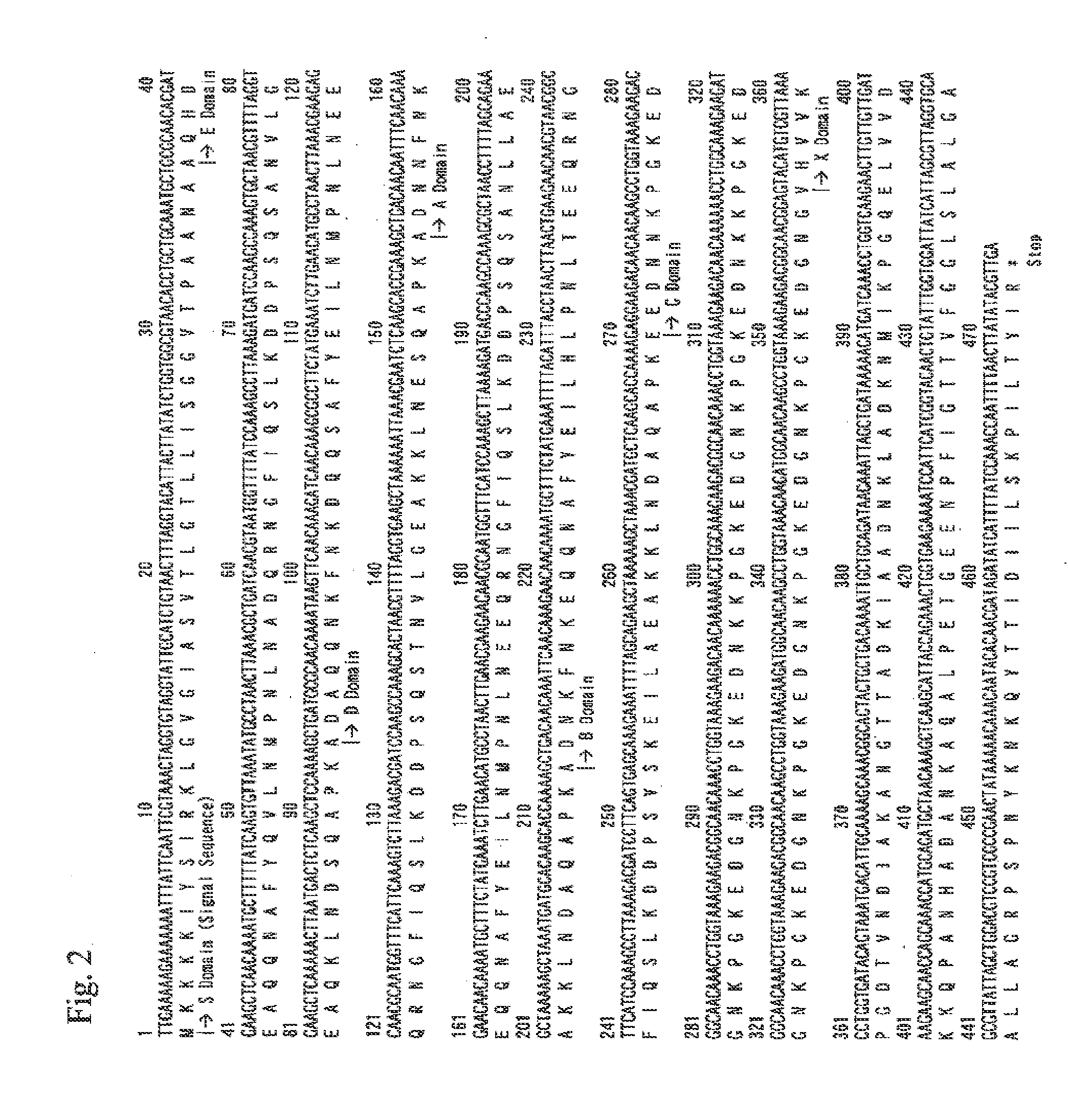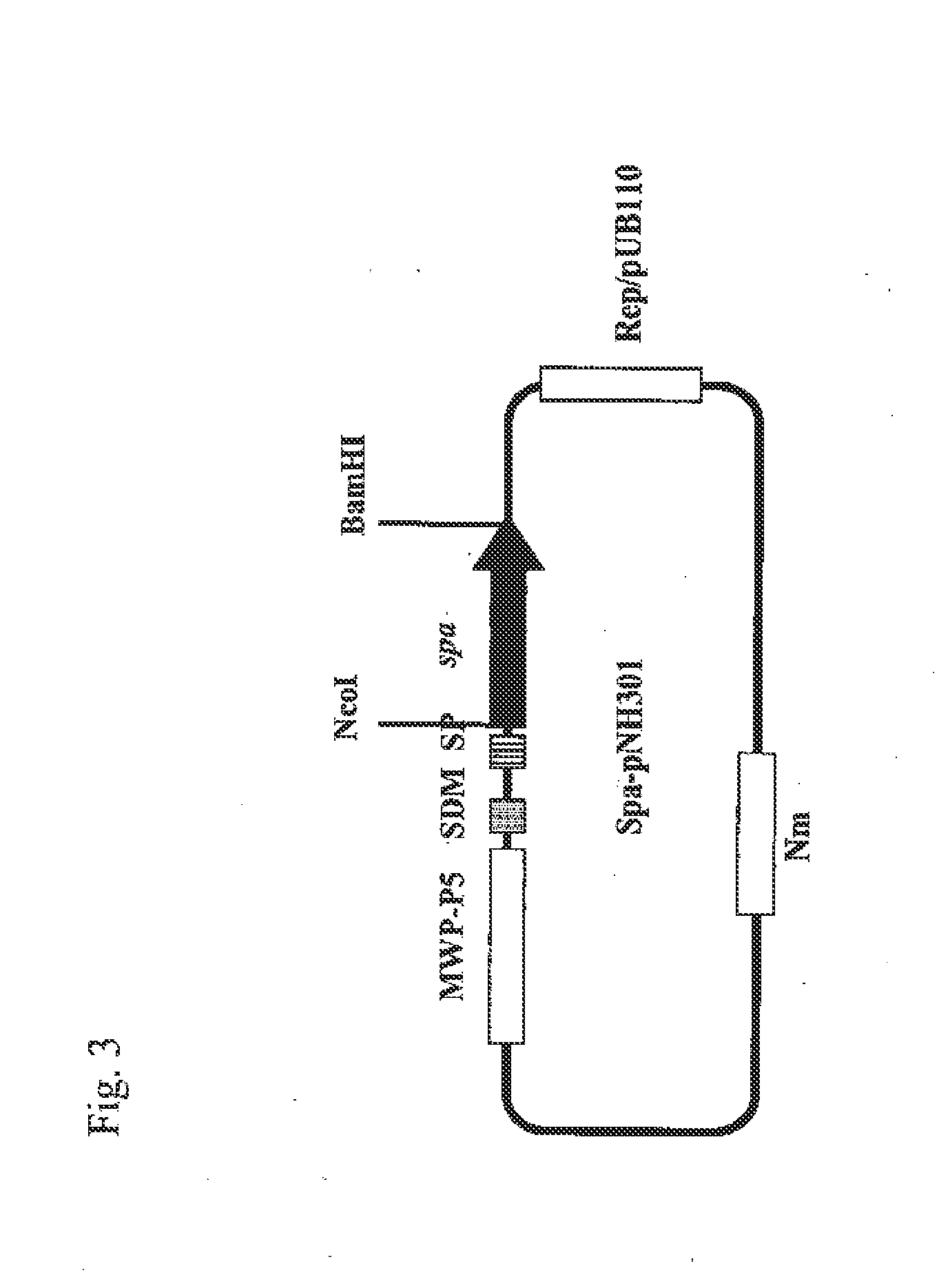Process for producing protein a-like protein with use of brevibacillus genus bacterium
a technology of brevibacillus genus and protein, which is applied in the field of process for producing protein alike protein, can solve the problems of large time and labor, low recombinant protein a productivity of i>escherichia coli /i>, and difficult separation and collection of proteins, etc., and achieves high purity and high yield. , the effect of improving the immunoglobulin-binding function
- Summary
- Abstract
- Description
- Claims
- Application Information
AI Technical Summary
Benefits of technology
Problems solved by technology
Method used
Image
Examples
example 1
Cloning of DNA Sequence Encoding Protein A Derived from Staphylococcus aureus ATCC 6538P Strain
[0077]Staphylococcus aureus ATCC 6538P strains were shake-cultured overnight at 37° C. in a T2 liquid medium (1% polypeptone, 0.2% yeast extract, 1% glucose, 0.5% fish extract, pH 7.0). Bacterial cells were collected from the obtained culture solution by centrifugation and then washed twice with 10 mM Tris-HCl buffer solution (pH 8.0). The bacterial cells were suspended in the same buffer solution, then lysed with 1% SDS, and heated at 60° C. for 30 minutes, followed by total genomic DNA extraction by standard methods such as phenol extraction and ethanol precipitation.
[0078]Next, two oligonucleotide primers 5′-TTGCTCCCATGGCTTTCGCTGCGCAACACGATGAAGCT-3′ (SEQ ID NO: 5) and 5′-CGGGATCCCTAAAATACAGTTGTACCGATGAATGGATT-3′ (SEQ ID NO: 6) were prepared on the basis of the DNA sequence information of the protein A gene (Non-Patent Document 6). PCR using these two oligonucleotide primers was performe...
example 2
Protein A Expression Test with Brevibacillus Genus Bacterium
[0082]The transformant obtained in Example 1 and a Brevibacillus choshinensis HPD31-OK strain used as a control, which had only the vector pNH301, were separately cultured at 30° C. for 3 days under aerobic conditions in a 3YC production medium (3% polypeptone S, 0.5% yeast extract, 3% glucose, 0.01% MgSO4.7H2O, 0.01% CaCl2.7H2O, 0.001% MnSO4.4H2O, 0.001% FeSO4.7H2O, 0.0001% ZnSO4.7H2O, pH 7.0) supplemented with 60 mg / L neomycin. The culture solutions were centrifuged (10,000 rpm, 4° C., 5 min.) to thereby remove the bacterial cells, and the resulting solutions were then subjected to SDS-PAGE by a standard method under reduction conditions using 10 to 20% gradient gel. After electrophoresis, the gel was stained with CBB to thereby detect a SPA band (FIG. 5). As a result of SDS-PAGE analysis, a large amount of SPA could be confirmed in the culture supernatant thereof.
[0083]To express full-length protein A also containing the...
example 3
Measurement of Antibody-Binding Ability of Protein A Produced by Brevibacillus Genus Bacterium
[0084]To confirm whether SPA produced by the transformant obtained in Example 1 had antibody-binding ability, mouse anti-human IgG antibodies and alkaline phosphatase-labeled rabbit anti-mouse IgG antibodies were used to conduct a binding test.
[0085]The Brevibacillus choshinensis HPD31-OK strains having either the Spa-pNH301 obtained in Example 1 or the pNH301 used as a control were cultured in the same way as in Example 2, and their respective culture supernatants were subjected to SDS-PAGE and then transferred to a PVDF membrane by a standard method. The membrane was blocked with 3% skimmed milk. An antibody binding test was conducted according to the method of Fahnestock et al (Fahnestock. S. R et al., J. Bacteriol. 1986. 165: 796-804). Detection was performed with an AP color development kit (manufactured by Bio-Rad) according to the instruction manual. As a result, no band was observed...
PUM
 Login to View More
Login to View More Abstract
Description
Claims
Application Information
 Login to View More
Login to View More - R&D
- Intellectual Property
- Life Sciences
- Materials
- Tech Scout
- Unparalleled Data Quality
- Higher Quality Content
- 60% Fewer Hallucinations
Browse by: Latest US Patents, China's latest patents, Technical Efficacy Thesaurus, Application Domain, Technology Topic, Popular Technical Reports.
© 2025 PatSnap. All rights reserved.Legal|Privacy policy|Modern Slavery Act Transparency Statement|Sitemap|About US| Contact US: help@patsnap.com



